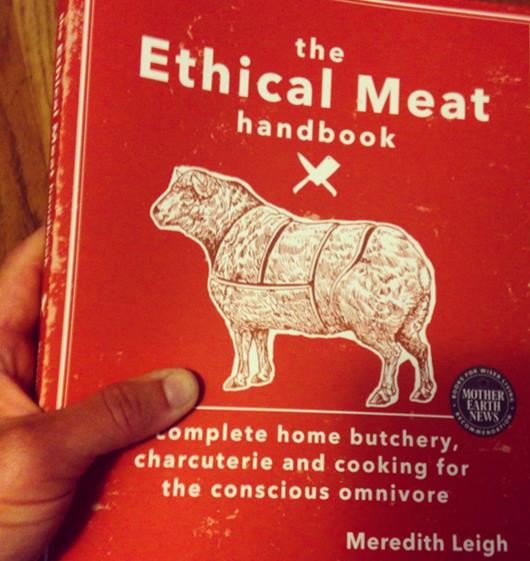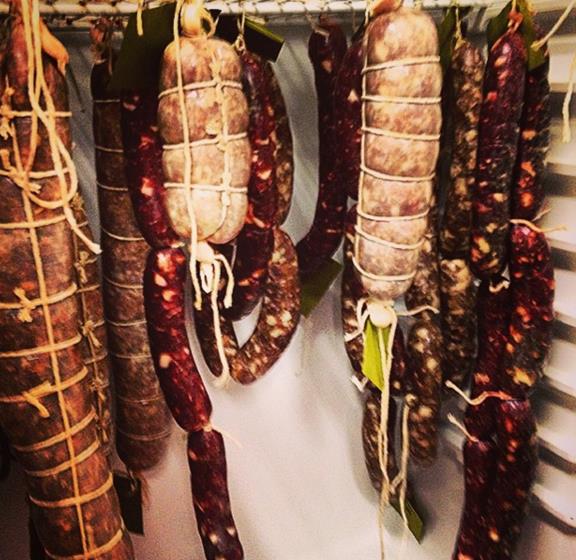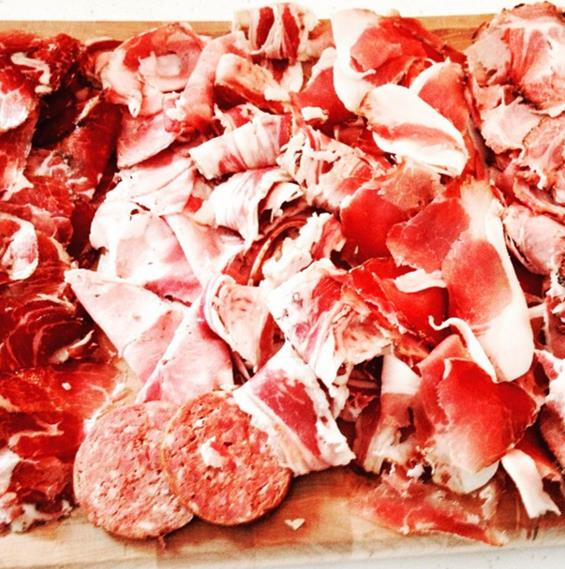By guest author Ciranna Bird, a freelance medical writer who shares her passion for humanely raised and harvested meat, dairy, and eggs on her NC Food Blog.
When Meredith Leigh presented at the 2015 Sustainable Agriculture Conference, I knew I found a kindred fan of bacteria. She said “If you see me standing before you as one individual, one organism you are wrong.” She told the audience about the good bacteria that lives in our human intestines, our mouths, the surface of our eyes, and skin. Without bacteria, our bodies wouldn’t be able to digest and extract minerals and vitamins from our food.

Ethical Meat, photo by Meredith Leigh
The information below is what I gathered from Meredith Leigh’s presentation, a follow-up one-on-one call with her, and the contents of her book. Her book is the Ethical Meat Handbook: complete home butchery, charcuterie and cooking for the conscious omnivore. The first component of ethical meat is that it comes from an animal that enjoyed a good life.
As part of providing animals a good life, she encourages farmers to allow the animal to act out its natural tendencies.
Cattle, pigs, lambs and chickens are best suited to eat food that their bodies were designed to eat, rather than providing them with a high starch grain diet.
The second aspect is allowing them enough space for rotational grazing which interrupts the life cycle of parasites that could harm the health of the flock. Better health reduces the need to provide antibiotics indiscriminately to all the animals. She says “Just as you depend on your gut flora to survive, cattle depend on communities of bacteria in their rumens to digest cellulose and other complex compounds in grass.” She says that “consuming so much grain, exposure to harmful bacteria and then being treated with antibiotics- changes the animal’s gut chemistry”. An imbalanced gut chemistry reduces the well-being of the animal as well as the humans that consume the animal.
Another aspect of ethical meat is that the humanely slaughtered animal meat should be properly butchered to maximize the use of the entire animal. Leigh provides presentations and written guidance for butchers and intrepid home cooks on how to handle large sections of beef, pork, lamb and chicken safely and efficiently. Her book has step by step cutting instructions and black and white pictures which reduces the blood and gore aspect of seeing animal muscles being separated into steaks, strips, ribs and loin chops.
Without the safe cooking and preserving of the well butchered meat that came from animals who had a good life and were humanely slaughtered, the meat would still fall short of being ethical. As meat eaters, we have the opportunity to learn how to cook and prepare meat in new ways that will improve our diets, save money, and provide ourselves with delicious food. This is where charcuterie, which is the science of converting raw meat into preserved meat that has an increased shelf life, enters the conversation.

Photo by Meredith Leigh
Although the word charcuterie is unfamiliar term to me, I am well acquainted with the final results. Before, I started choosing to eat meat that was humanely raised, I use to love buying bacon, salami, bologna, liverwurst, and pepperoni from the deli counter at my nearby grocery store. In chapter 4 of the Ethical Meat Handbook, Meredith provides step by step instructions on how I can make my favorite deli meats at home.
As a prior microbiologist who grew Salmonella, Shigella and E.coli 0157 in petri dishes to identify the source of foodborne outbreaks, my favorite chapter is Chapter 4: Charcuterie. In this chapter Meredith Leigh reminds readers that animal meat has bacteria. And for the most part the bacteria is non-harmful just like the types of bacteria that live in our digestive system, mouths, surface of our eyes, and skin. However to protect yourself and those you prepare food for, it is important to reduce the exposure to bacteria that cause foodborne diseases. She reminds shoppers to keep raw meat from touching the vegetables they buy at the farmers market. Raw chicken and turkey meat carry more bacteria than pork, while meat and lamb carry the least amount of bacteria. Therefore, butcher shops and restaurants put eggs and chicken meat on the bottom shelf of the refrigerator to prevent them from dripping on anything else. Pork meat is stored on the second shelf, while beef and lamb get stored on the third highest shelf in the refrigerator.
There are six tools to promote the growth of helpful bacteria such as Lactobacillus, Pediococcus, and Kocuria which are vital for the fermentation and curing of meat, while decreasing the growth of harmful bacteria like Campylobacter, Listeria, and Clostridium botulinum. The toxin of Clostridium botulinum is familiar to me, because while I worked for the Massachusetts Department of Health isolating E.coli 0157 from people who ate improperly cooked hamburgers, my co-workers were isolating C. botulinum from baby food and honey. This bacteria’s toxin causes botulism which may lead to paralysis and death. Sorry, I got carried away with bacteria. Here are the six tools:
- Salt reduces the water activity in the meat and it effects the growth and metabolism of bacteria.
- Temperature can slow the growth or eliminate harmful microorganisms while promoting the growth of beneficial bacteria.
- Humidity, which is the moisture in the air, is critical to proper drying of fermented meats.
- Smoke contains compounds that will slow or stop the ability of bacteria to grow and prevents rot.
- pH, which is the acidity of a product, affects the bacteria responsible for fermenting, curing, and flavoring the meat.
- Nitrites and nitrates slow the process of meat becoming rancid and prevent the growth of Clostridium botulinum spores
To prevent these tools from becoming too abstract, let me relay a conversation Meredith had during one of her previous presentations. A child in the audience said his birthday was coming up. She jokingly suggested he ask his mom for an entire pig carcass. Why? Because he could take the ham leg, bury it in a box with kosher salt for a certain amount of time, and then hang it in his bedroom closet for six to 12 months to create prosciutto. The salt reduces the water activity, and the hanging in a dark cool space with high humidity causes the ham to lose 40% of its weight and therefore becomes safe to eat at room temperature. No cooking involved. Crazy cool, I know.
But why would you want to make your own cold cuts, bacon, or prosciutto? Albeit for me, it sounds like a fun science experiment. The reason is that creating your own deli meats helps small-scale farmers earn a living. In her book, Meredith indicates that transforming ethically raised animal carcasses into chops, and sausages is very expensive for small-scale livestock farmers. This process called the “cut and wrap” happens either at the slaughterhouse, butcher shop, or grocery store. Charcuterie enables the customer to buy and store larger sections of an animal in their own home which helps the small-scale livestock farmer and reduces the customer’s grocery bill.

Photo by Meredith Leigh
In conclusion, bacteria play a vital role in helping the bodies of animals and humans digest food. The good bacteria also have vital role in the fermentation and curing to transform raw meat into delicious deli meats. There are important precautions to take to avoid harmful bacteria from causing foodborne illnesses and spoiling the precious meat that has been ethically raised, butchered and prepared.
Note: Meredith Leigh speaks throughout the United States about food, farming, butchery, and cooking. Her audiences include food citizens, chefs, culinary students, farmers, food distributors, and educators. Visit her website to find out how to enroll in her hands-on butchery classes, and meat ethics workshops.


